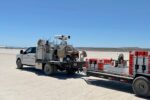The French Army has officially inducted the Griffon MEPAC (Mortier Embarqué Pour l’Appui au Contact) into operational service with the 3rd Marine Artillery Regiment (3e RAMa), marking a significant milestone in its modernization of mobile indirect fire support capabilities. Based on the VBMR Griffon platform and armed with a rifled 120 mm mortar system integrated by Thales and TDA Armements (a Nexter subsidiary), the MEPAC is designed to deliver rapid-response precision fires while fully integrating into France’s SCORPION C4ISR architecture.
Griffon MEPAC: A Digitized Mortar System for Modern Battlefields
The Griffon MEPAC is a variant of the VBMR (Véhicule Blindé Multi-Rôles) Griffon multirole armored vehicle developed under France’s SCORPION program—a comprehensive modernization effort aimed at overhauling its land forces’ mobility, protection, and command capabilities. The MEPAC configuration transforms the standard troop transport Griffon into a self-propelled mortar carrier equipped with a breech-loaded 120 mm rifled mortar system supplied by TDA Armements.
The mortar is mounted inside the vehicle and fires through roof hatches while remaining under armor protection. This setup allows crews to operate in high-threat environments without dismounting. The system includes an automatic laying mechanism and digital fire control suite integrated with SCORPION’s SICS (Système d’Information du Combat Scorpion) battle management system. This enables networked fire missions coordinated in real time across joint units.
The primary weapon is capable of delivering high-explosive rounds up to approximately 13 km using rocket-assisted projectiles. Standard HE rounds reach around 8 km. Rate of fire is typically six to ten rounds per minute depending on mission profile and barrel heating constraints.
Operational Integration with the 3rd Marine Artillery Regiment
The first operational unit to receive the Griffon MEPAC is the 3e RAMa (Régiment d’Artillerie de Marine), part of France’s Troupes de Marine under the Rapid Reaction Corps framework. Based in Canjuers training area during initial deployment phases in late September and early October 2025, regiment personnel conducted live-fire training alongside other SCORPION-equipped units.
According to official statements from France’s Direction Générale de l’Armement (DGA) and Army Command (CEMAT), this induction marks an important capability leap for expeditionary artillery formations. The ability to deliver indirect fire support from within armored vehicles—without needing external setup or exposure—enhances survivability and responsiveness during maneuver warfare or urban operations.
Each vehicle carries a crew of four: driver, commander/gunner, loader/operator, and systems operator. Ammunition loadout includes up to 60 rounds onboard depending on configuration—typically a mix of HE shells and illumination or smoke munitions.
SCORPION Ecosystem Integration
A key feature distinguishing MEPAC from legacy mortar carriers is its full integration into SCORPION’s digital ecosystem. This includes:
- SICS Battle Management System: Enables real-time targeting data exchange between forward observers, command posts, UAVs/drones like SMDR or NX70 micro-UAVs used by French forces.
- Vetronics Suite: Shared across all Griffon variants; provides standardized displays/interfaces for navigation, targeting input/output, vehicle diagnostics.
- Interoperability: Compatible with NATO-standard digital fires protocols such as ADLER III or ASCA for multinational operations.
This digitization reduces sensor-to-shooter timelines dramatically—from minutes down to seconds in some scenarios—and supports decentralized mission execution aligned with modern multi-domain operations concepts.
Industrial Team Behind MEPAC Development
The Griffon platform is manufactured by Groupement Momentané d’Entreprises (GME) formed by Nexter Systems (now part of KNDS), Arquus (formerly Renault Trucks Defense), and Thales. For the MEPAC variant specifically:
- TDA Armements: Supplies the rifled breech-loading mortar system derived from its MO-120 RT family; also responsible for recoil mitigation mechanisms allowing safe firing from inside vehicle hulls.
- Nexter: Leads final integration work including internal layout redesigns for ammunition stowage racks and crew ergonomics tailored to artillery use cases.
- Thales: Provides vetronics backbone including SICS terminals and secure comms modules enabling encrypted C2 links across echelons.
The first batch deliveries began in mid-2025 following qualification trials conducted jointly by DGA TechLand test centers at Bourges and Canjuers starting in late 2024. According to open sources including Jane’s Defence Weekly and French defense outlet Zone Militaire/Opex360.com, production targets aim for around 54 vehicles delivered through FY2027 as part of Lot #1 procurement cycle under SCORPION phase two contracts signed in late 2021/early 2022.
Tactical Role Within Future Force Structures
The introduction of Griffon MEPAC aligns with broader shifts toward highly mobile “combat groups” within French brigades—where each combined-arms unit includes organic ISR assets (mini-drones), protected mobility platforms like VBMR-L Serval or EBRC Jaguar recon vehicles, plus integral indirect fire elements like MEPAC or CAESAR NG systems at higher echelons.
This modularity allows rapid tailoring of force packages based on terrain or mission type—from counter-insurgency patrols in Sahelian Africa to high-intensity peer conflict scenarios envisioned under NATO Article V contingencies. The ability to deliver accurate fires within minutes after halting—without needing baseplate setup like traditional mortars—is critical for shoot-and-scoot survivability against counter-battery threats including loitering munitions or UAV-directed artillery common in recent conflicts such as Ukraine-Russia warzones.
Ahead: Future Enhancements & Export Potential?
No official export contracts have been announced yet for Griffon MEPAC; however several countries operating MO-120 RT mortars—including Belgium and Saudi Arabia—may find interest if paired with compatible wheeled platforms. Additionally, future upgrades could include automated loading systems or guided munitions integration such as STRIX GPS/IR-guided mortar bombs developed by Saab Bofors Dynamics under NATO STANAG standards compatible with rifled tubes like those used on MEPAC.
The system may also benefit from integration with emerging AI-enabled fire coordination tools being tested under EU-funded projects like FAMOUS or EDF-supported programs aimed at next-gen tactical C4ISR convergence across European land forces post-2030 horizon planning cycles.









